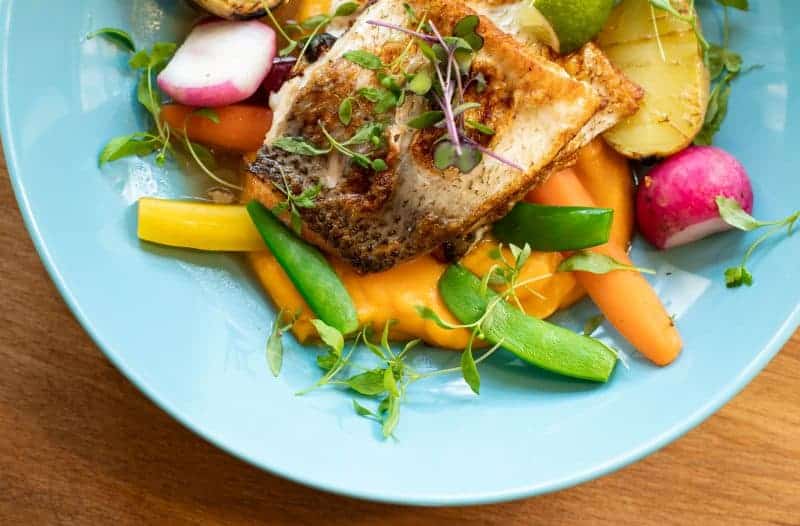Dalmatian Food And Wine Pairing: A Delectable Guide
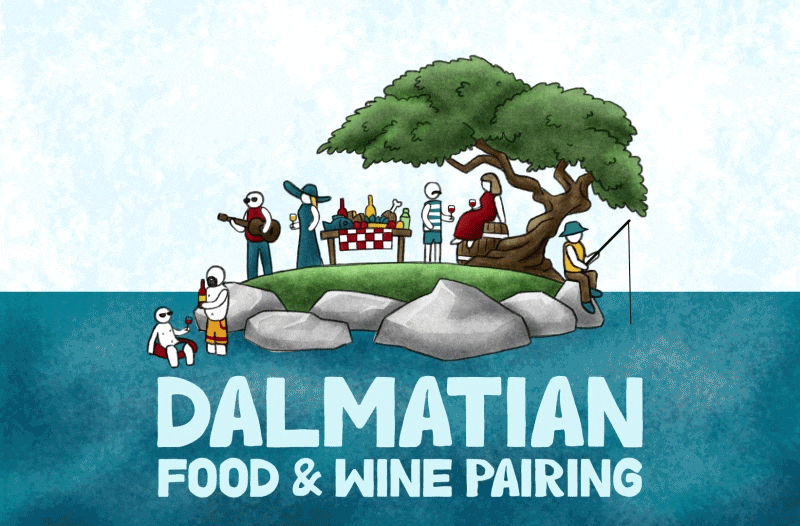
The culinary tradition of Dalmatia
Exploring Croatia’s Dalmatian cuisine is a dream come true for food enthusiasts. Every recipe and dish reflects the deep love for food ingrained in Dalmatian lifestyle and culture.
Before we delve further into discussing its culinary tradition, let’s pinpoint where Dalmatia is located.
As the map below shows, Dalmatia is located on the eastern coast of the Adriatic Sea in Croatia, stretching from the island of Rab to the southern tip near Dubrovnik.
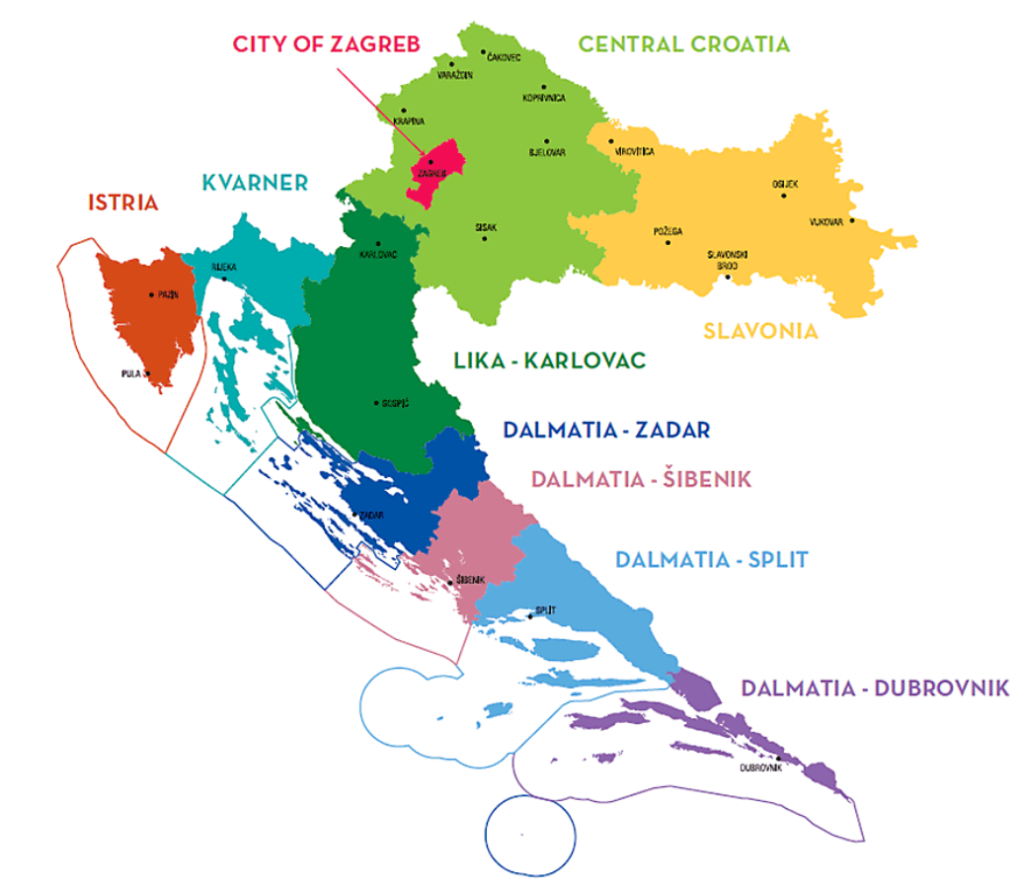
Dalmatian cuisine gets its special flavor from using local ingredients and traditional cooking methods passed down over generations. The region’s deep appreciation for delicious food is what makes its cuisine so unique.
Rich in seafood and featuring plenty of authentic meat dishes, Dalmatian cuisine blends numerous Mediterranean flavors into its fares. The coastal atmosphere and timeless traditions define the heart and soul of its cuisine.
Influences from Mediterranean and Adriatic cuisine
Croatia’s rich history has shaped its diverse culinary scene, and Dalmatian cuisine is a prime example. Strongly influenced by the natural riches of the region, it’s a blend of cultural influences that have evolved over time, resulting in a truly unique culinary tradition.
From ancient Roman and Greek flavors to Italian influences, Dalmatian cuisine tells a captivating story of merging cultures. A living narrative that has created an inspired and regionally distinctive menu.
In Dalmatia, the food culture is heavily influenced by the Adriatic Sea’s bounty, the Mediterranean’s culinary history, and the fertile lands of the Dalmatian countryside, all shaped by historical factors. Seafood takes the spotlight, reflecting the region’s cooking traditions. Simple yet vital ingredients like olives, olive oil, local cheese, fresh herbs, figs, carob, and other Mediterranean fruits are key elements in these dishes, offering flavors that deeply resonate with locals. And the wines made here for centuries are the perfect match for this unique cuisine.
Dalmatian wine is key in making these meals even better. When you’re in this area, you’ll discover lots of local grape varieties that go perfectly with the diverse flavors of Dalmatian cuisine. Whether you’re enjoying a refreshing white wine with grilled seabream or a rich red with braised beef stew, there’s always a perfect pairing that makes both the food and the dining experience even more special.
With such strong roots and connections to both land, wine, and sea traditions, pairing Dalmatian dishes with wine is like tasting history.
Pairing wine with Dalmatian cuisine
People have been making wine in Croatia for thousands of years. In fact, one of the oldest continuously planted vineyards in the world is Stari Grad Plain, located on the island of Hvar in Croatia.
This must-visit Croatian UNESCO World Heritage site is known for its ancient agricultural landscape, particularly its vineyards. Since Greek Antiquity, the land has been continuously farmed, with well-preserved dry stone walls dividing it into parcels. These vineyards are historically significant, contributing greatly to the island’s economic and cultural development.
Croatia, especially its Dalmatian coast, is a destination every wine lover should visit as it offers the opportunity to taste some of Croatia’s finest and most complex wines.
Pairing those wines with Dalmatian cuisine involves considering the regional wine’s unique characteristics to complement the flavors and textures of local dishes. Balancing acidity and tannins will highlight the rich flavors of authentic Dalmatian delicacies.
Whether you’re pairing wine with iconic dishes like octopus cooked under a bell (known as peka), or with dishes like squid ink risotto, steamed mussels, and fish stew, there’s always a local wine that pairs perfectly.
Complementing flavors and textures
The way a dish is prepared is as important as the choice of the main ingredient itself. Therefore, consider the texture of the dish and look for a stylistic match in wine.
For example, the popular term “white fish” encompasses a variety of dishes, making it difficult to predict the suitable wine. However, if you know how it’s prepared, the decision becomes easier. If it’s boiled or steamed, opt for light white wines like Kujundžuša or Bogdanuša.
Additionally, Dalmatian whites such as Maraština or Vugava, offer a refreshing contrast to seafood-centric dishes like brodet and scampi na buzaru. The crisp acidity of the wine cuts through the richness of these recipes, enhancing the delicate flavors of the fresh seafood.
If it’s grilled, serve Pošip or Debit. And if it’s baked or roasted, spicy, and swimming in oil, then aged and barrique-aged Pošip or macerated Maraština would be ideal.
The same principle applies to all other ingredients. The texture of the food determines the choice of wine, so take the following advice with caution and adjust it according to the texture of the dish as needed.
Balancing acidity and tannins
To create a harmonious pairing, it’s essential to balance the acidity of dishes with the tannins in wine. The bright acidity in food can be offset by choosing a wine with softer tannins.
Similarly, if the dish has lower acidity and richer flavors, a wine with higher tannin content can complement it well. By finding this equilibrium between the two elements, you can enhance the dining experience.
Knowing how to balance acidity and tannins opens up an array of possibilities for creating delightful pairings. It ensures that neither element overpowers the other, allowing both food and wine to shine together.
Authentic Dalmatian dishes to try
Explore a rich variety of authentic flavors of Dalmatia with a tempting selection of dishes waiting to be enjoyed. Treat yourself to classic Dalmatian delicacies for a genuine food and wine pairing experience.
Janjetina ispod peke (slow-cooked lamb under the bell)
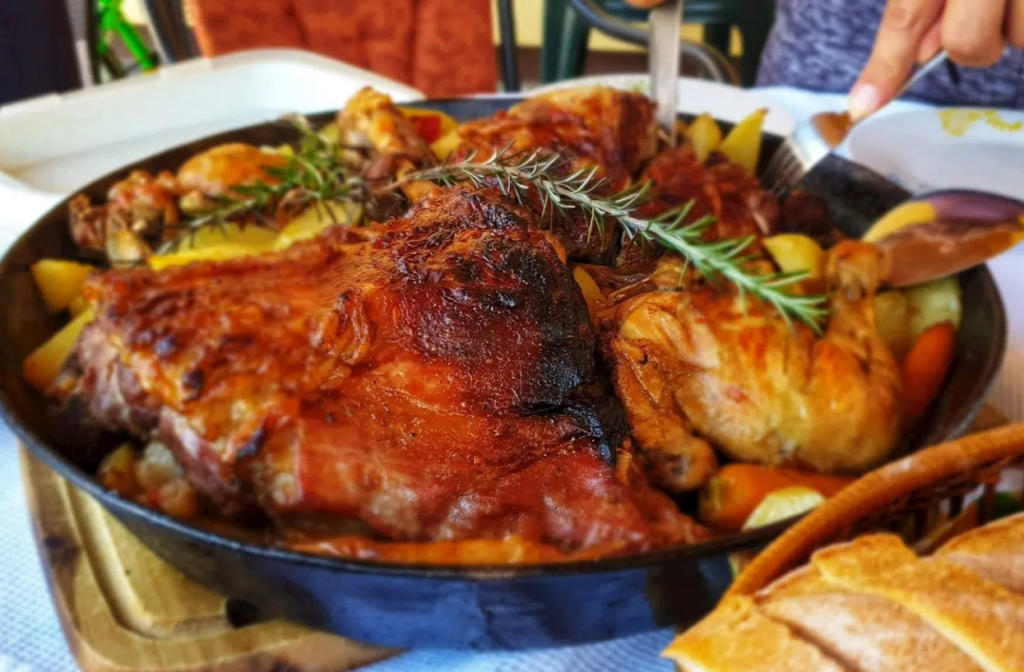
Although the coastal region is famous for fish dishes, the Dalmatians are also experts in preparing meat dishes.
Peka is a bell-shaped lid made of cast iron, perfect for cooking various dishes, typically containing meat, veggies, and herbs.
Peka is a traditional cooking method commonly used for preparing dishes. In restaurants, you’ll find a range of peka dishes available, including veal, chicken, lamb, or octopus prepared in this way.
It involves placing the food under a cast-iron dome. Then, it’s cooked over an open fire with hot coals and embers on top of the lid. The dish simmers slowly in its own juices for several hours until the meat becomes tender.
Because it’s covered the whole time, it keeps all its delicious flavors and aromas. The dish is often seasoned with traditional Dalmatian herbs like rosemary and sage, then slow-roasted.
The result is succulent, flavorful meat that effortlessly falls off the bone.
Janjetina ispod peke (lamb under the bell) is a particularly beloved regional culinary specialty. It features lamb slow-cooked to perfection underneath the peka lid, allowing the meat to absorb aromatic flavors while remaining incredibly tender.
This dish is best paired with wine with a strong structure and expressed tannins, such as Vislander Plavac Mali Tihobraće. Its powerful structure and tannins beautifully complement the savory flavors of the dish, softening the meat’s texture and making the meal even more enjoyable.
Pašticada (braised beef stew)
Now, let’s transition to another traditional Dalmatian dish that promises a burst of rich flavors – Pašticada. This braised beef dish is packed with aromatic spices and is typically served with homemade pasta or gnocchi. It’s a staple dish in Dalmatian cuisine!
To make pašticada, beef is marinated in vinegar and spices for a couple of days, then stewed in red wine or Prošek along with bacon, tomatoes, dried prunes or figs, and root vegetables.
Traditionally, this dish is enjoyed at weddings, gatherings, or other special occasions. For an extra touch, we recommend serving it with a sprinkle of grated cheese on top.
Pašticada is an ideal pairing for Plavac Mali Milna from Vislander Winery, a harmonious wine with a strong structure, and pronounced tannins.
Whether it’s a special occasion or a family gathering, this hearty dish never fails to impress with its depth of flavors and cultural significance in Dalmatia.
Brujet, brudet or brodet (fish stew)
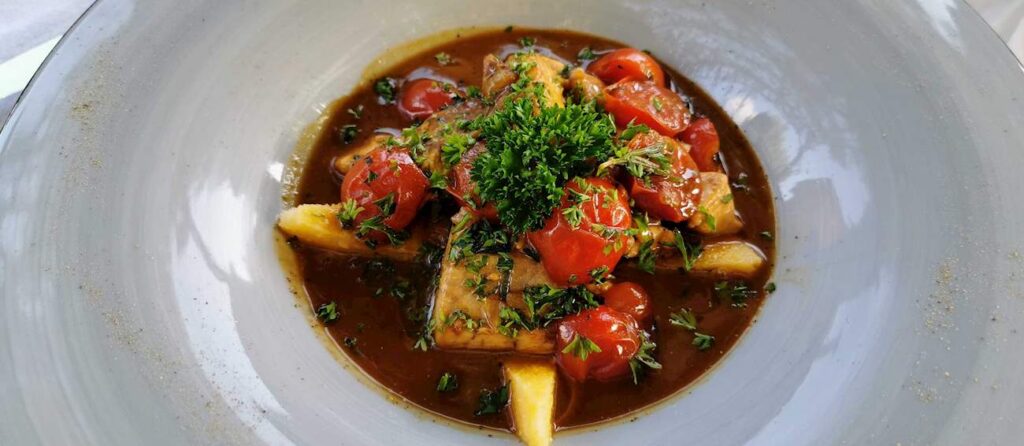
Moving on from the savory slow-cooked meats, let’s delve into another iconic dish of Dalmatian cuisine – Brudet. Fish brudet is a fantastic traditional dish prepared throughout the Croatian regions of Dalmatia, Kvarner, and Istria. Some call it brujet, some brudet, and some brodet. And the trouble doesn’t end there because, besides numerous names, there are also plenty of recipes.
For fish brudet, you can use various types of fresh fish, shellfish, and crustaceans. We’ll mention just a few such as monkfish, grouper, scorpionfish, and hake, and you can also add shrimp and other crustaceans and shellfish. Generally, the rule is, the more types of fish, the tastier the brudet. But don’t be immediately scared off and give up preparing this delicacy because you can literally make it from anchovies.
These ingredients are simmered in a savory tomato-based sauce enriched with Mediterranean herbs and spices, along with the aromatic infusion of onions, garlic, and a drop of vinegar to create a delightful harmony that underpins this beloved Croatian dish. Covered in water it cooks on low fire until the fish is done. Laurel and chili pepper are sometimes added to the stew to your taste.
Brudet is typically served with polenta (pura, polenta, or žganci), which is simply poured over with the brudet sauce.
It pairs perfectly with Vislander Bugava Antique, a wine that is simultaneously creamy and vibrant, harmonious, full-bodied, more structured, and layered with beautiful progression on the palate.
Black risotto
Black risotto, a famous dish in Dalmatian cuisine, is made with squid ink, rice, garlic, onion, and various seasonings. This seafood delicacy has a bold taste that fish lovers will adore.
To make black risotto, start by toasting the rice briefly. Then, add a bit of water, white wine or Prošek, and your preferred sauce. Clean a freshly caught cuttlefish thoroughly, and carefully remove the black ink, which the cuttlefish uses as a defense mechanism. Dilute the ink and add it to the dish just before finishing cooking to give the risotto its distinctive black color.
In addition to the cuttlefish, the unique flavor of this risotto comes from Prošek, a sweet Dalmatian dessert wine often added during cooking.
Despite its strong seafood flavor, this risotto makes for a perfect dish if you choose to try a multi-course menu. It’s a must-try for anyone exploring Dalmatian culinary specialties and pairs well with Maraština or with the Korčula Island indigenous variety – Pošip. As you delve into the world of Dalmatian gastronomy and wine culture, add black risotto to your list of dishes to savor.
Scampi buzara (Shrimp) in red tomato sauce
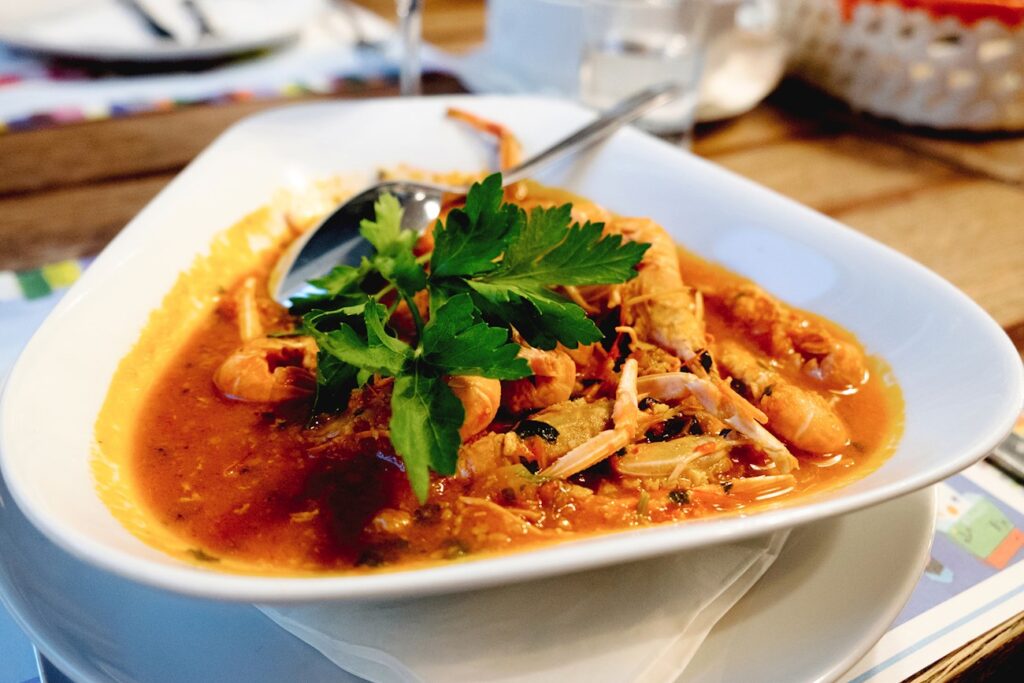
Scampi Buzara in red tomato sauce is a flavorful Croatian dish featuring scampi cooked in a rich tomato-based sauce.
The scampi, or prawns, are typically sautéed with garlic, onions, and tomatoes, creating a savory and aromatic base. Various herbs and spices such as parsley, basil, and red pepper flakes are often added to enhance the dish’s depth of flavor.
The sauce is simmered until the scampi are cooked through and infused with the vibrant flavors of the tomato sauce. Served hot and garnished with fresh herbs, Scampi Buzara in red tomato sauce is a delightful seafood dish that captures the essence of Mediterranean cuisine.
This technique of cooking is typical of coastal Croatia, especially of the Dalmatia and Istria regions, and seafood-based dishes similar to this one are commonly served with crusty bread for soaking up the delicious sauce.
While the most common choice of seafood for this type of dish is scampi (škampi) or mussels (dagnje), clams, prawns, lobsters, limpets, or even small fish are also often cooked using this method.
Choosing the right wine for tomato sauce dishes can be tricky. You’ll want a wine that balances the acidity of the sauce while complementing its sweetness and depth.
When tomatoes are raw, they’re quite acidic, but cooking them mellows out the acidity and brings out their sweetness, giving you more options for wine pairing.
We like to go for the adaptable fresh, lively red Darnekuša, known for its low tannins and high acidity. Alternatively, Plavina is also a good choice, lower in alcohol and with softer tannins, yet with higher acidity.
For scampi buzara, a crisp, fresh rosé with enough body to complement the red sauce is also recommended. Try Vislander Rose. A wine with lively acidity adds a playful balance to the concentrated flavor of the full-bodied southern rosé, crafted from Plavac Mali grapes.
Dalmatian mussels buzara (Dagnje na buzaru)
Buzara is a local name for “stew” and it is an integral part of the Adriatic part of Croatian cuisine. It is most often prepared with shells or crabs.
Dagnje na buzaru or Dalmatian mussels buzara is a traditional dish of the Croatian coast prepared with mussels as the main ingredient.
The mussels are cleaned and placed in a pot with lukewarm water, covered, and gently heated until they open up. In a separate pan, olive oil, garlic, parsley, and a bit of pepper are sautéed, then combined with the mussels along with a few slices of lemon. White wine is added for extra flavor, and the dish is simmered briefly. Before serving, breadcrumbs are often sprinkled over the mussels to thicken the sauce, and the dish is served with plenty of bread on the side for dipping into the delicious juices.
Mussels pair nicely with richer white wines such as Vislander Bugava Premier.
Certain popular recipes showcase fresh mussels cooked in a savory red tomato wine sauce, enriched with fragrant garlic and parsley. When served with a red sauce, the wine pairing principles remain the same as with scampi.
Ston oysters and mussels
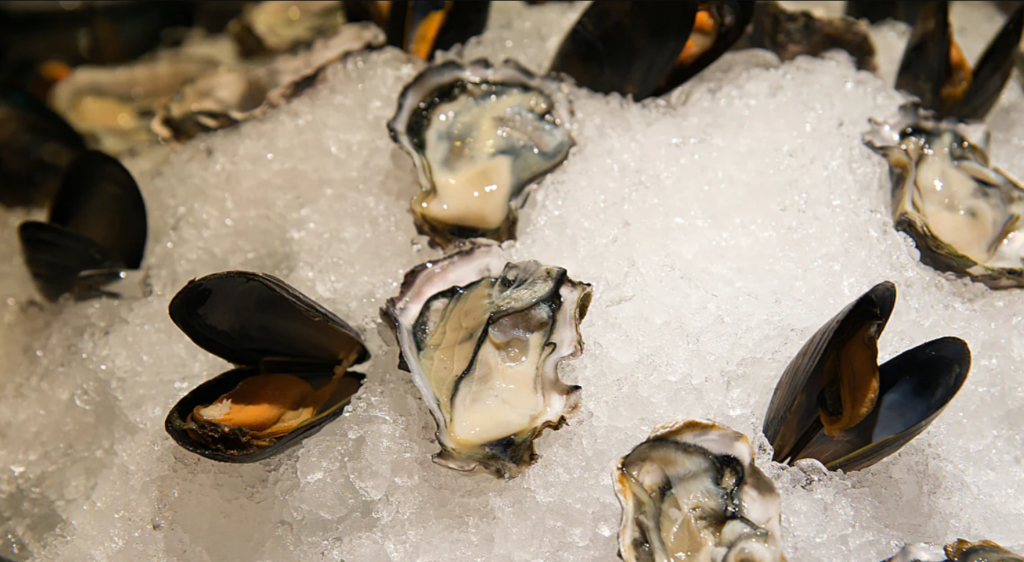
Oysters and mussels from Ston and Mali Ston, are equally adored among locals and tourists. The eastern part of the Pelješac Peninsula, namely the Ston municipality, is an area known for growing mussels and European flat oysters of superior quality. The area’s ideal conditions, including clean seawater and a suitable marine environment, contribute to the exceptional flavor and texture of the shellfish.
Oysters have been cultivated in the Dalmatian area since ancient Roman times. The locals here continue to farm the European Oyster, which is nearly extinct in other places. They’re most delightful when eaten raw and tender, served on ice with a splash of lemon juice.
When served with chilled young and fresh Kujundžuša, Debit, or sparkling wine with intense and playful acidity, such as Vislander Komiška Bonda, a blend of Kuč and Vugava varieties, you’re in for a truly special gastronomical experience.
Adriatic squid in a pan (Jadranske lignje na padelu)
Jadranske lignje na padelu is a traditional Dalmatian dish made with fresh squid, olive oil, white wine, fish stock, garlic, parsley, pepper, and potatoes. The squids are first cleaned and seasoned, then sautéing them in olive oil with garlic and parsley, adding white wine, and simmering until cooked.
The combination is further enriched with the addition of wine, fish stock, and potatoes. The dish is a staple during summer in Dalmatia, and it is recommended to pair it with a glass of Debit wine on the side.
Riba na gradele (grilled fish)
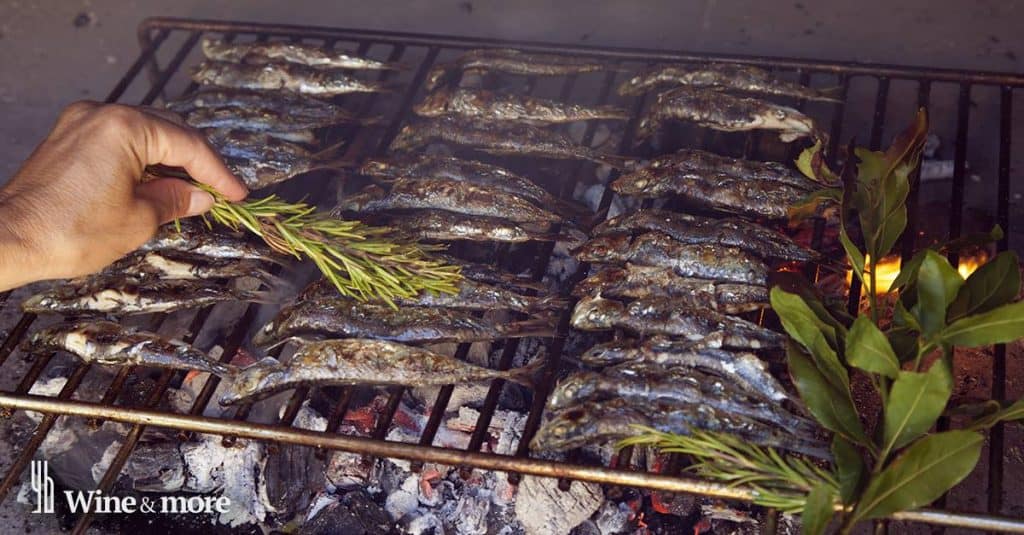
Grilled fish or riba na gradele is a traditional way of cooking fish along the Dalmatian coast. It involves grilling the whole fish, head and all, over an open fire, whether at home or in restaurants. The fish, dried to remove excess moisture, is placed on the grill grates of a preheated grill (called gradela), typically fueled by wood or charcoal. During cooking, the fish is basted with rosemary-infused olive oil.
Grilled fish, brushed with local olive oil the fish is typically served with blitva (swiss chard), boiled potatoes, and a sauce made of olive oil, parsley, and garlic. It’s a quintessential Dalmatian dish.
Grilled white fish with stronger flavor pairs well with fresh and lively wines with pronounced minerality such as Malvasia, lighter Graševina, and Vugava. If the fish is oily and strongly seasoned, pair it with aged Pošip or macerated Malvasia.
For bluefish or fish with more intense flavors from the grill, opt for fuller and stronger white wines such as Debit, macerated Maraština, Pošip, aged Chardonnay and Malvasia.
Gregada (fish stew)
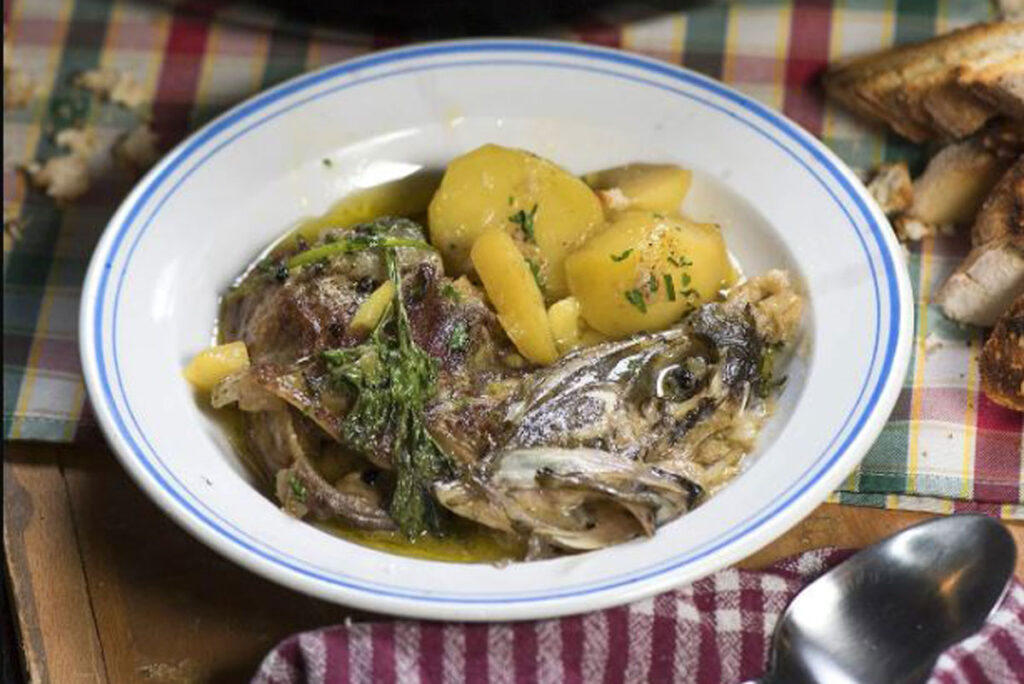
Gregada, a fish stew, is cooked over high heat, setting it apart from its relative brudet. Believed to have originated with the ancient Greeks on the island of Pharos (Hvar), this straightforward fish stew with potatoes is believed to be the oldest method of preparing fish in Dalmatia.
It likely originated with Greek settlers over 2000 years ago, although potatoes were added later since they were introduced to the region much later on.
In the traditional method, this dish starts with layers of thinly sliced potatoes and onions. They’re then drizzled with olive oil, topped with smaller white saltwater fish, and cooked in a mixture of water and white wine, just enough to cover the fish. Typically, parsley and garlic are added, but modern versions might include extras like capers and salted anchovies.
A staple among local fishermen, gregada is prepared throughout the region, but it is mostly associated with central Dalmatian islands, especially the island of Hvar.
Gregada pairs beautifully with vibrant Pošip wines which can accompany the delicate richness of the stew and will harmonize effortlessly with the texture of the stew without overpowering it.
Pag cheese
The Croatian island of Pag is renowned for its sheep cheese, called Paški sir. This cheese is made from the milk of a special local breed of sheep, prized for their milk’s unique taste, nurtured by grazing on herbs in the salty sea breeze. It’s a firm, aged cheese with a salty kick, made in limited batches, and highly sought after for export.
You can find Pag cheese in numerous restaurants across Dalmatia, as well as in stores, available as both young and aged, hard cheese.
Hard cheese from Pag is known for its bold, intense flavor. As such it pairs best with wines that match its strength.
For white wines, options like full-bodied Pošip, Malvasia Istriana, or Graševina work well, depending on your taste preferences.
As for red wines, recommendations are Plavac Mali (try Vislander Plavac Mali Ljubišće), Teran, and Babić.
Dalmatian prosciutto
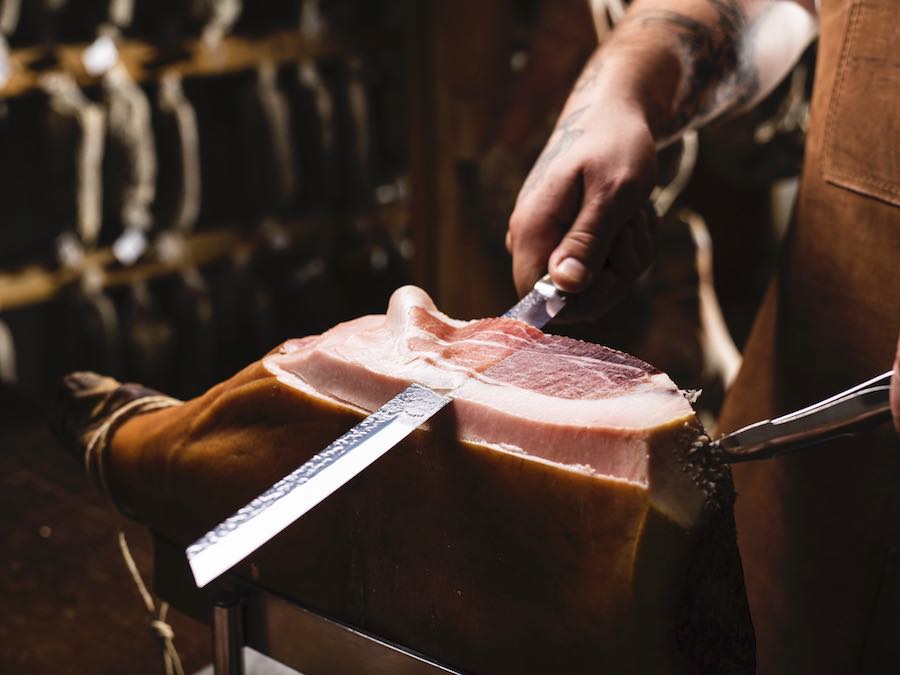
One of Croatia’s trademarks, especially in Dalmatia, is dry-cured pork, known as Dalmatian pršut.
Dalmatian pršut is a cured, smoked, and dried ham, often served thinly sliced with bread, cheese, or fruit like melon. Unlike its Italian (prosciutto) and Istrian counterparts, Dalmatian pršut is wood-smoked and dried for a minimum of twelve months. It takes at least a year for the cold northeastern wind, called bura, to cure the meat, resulting in thin slices of flavorful delicacy.
It is produced with fresh pork legs, complete with bone, skin, and fat. After being dry-salted, pressed, and seasoned, it’s smoked and left to air-dry and mature. During this final stage, the cold, dry bura wind plays a crucial role, creating ideal conditions for maturation.
It’s a favorite for both casual gatherings and special celebrations, appreciated for its rich sweet-salty flavor.
Drniš prosciutto in particulary stands out as one of Croatia’s finest, crafted since the 14th century. The unique microclimate around Drniš, characterized by sub-Mediterranean conditions, lends this ham its distinctive character, setting it apart from those made in other parts of Dalmatia.
Smoked prosciutto, with its intense and rich flavor, poses a challenge when it comes to wine pairing.
As with Italian prosciutto and Sangiovese pairing, red Dalmatian wines with firm tannins, and higher acidity are often the best choice. Wines made from native Babić or even Plavina will create an outstanding contrast while enhancing the smoky character of the prosciutto.
It’s worth mentioning that the choice of wine with prosciutto is not limited to red wines only.
Prosciutto goes best with a crisp, fresh Debit, dry with a brilliant acidity to wash away the fat of each bite.
Soparnik
Soparnik is a traditional Dalmatian dish, a tasty pie filled with chard and onion, originating from the Poljica region in central Dalmatia.
Once a humble meal, it’s now considered a gastronomic delicacy, best enjoyed with a glass of fine Dalmatian wine.
Soparnik consists of two layers of thin dough filled with Swiss chard, parsley, and garlic, ingredients accessible even to those with modest means. It holds the distinction of being the first Croatian dish to achieve cultural heritage status.
What’s intriguing about soparnik is its baking method: it’s cooked on hot coals covered with ash, punctured to release steam, and baked briefly. Once done, the ash is removed, and the pie is brushed with olive oil and sprinkled with crushed or finely chopped garlic.
Drizzling olive oil over warm soparnik and pairing it with Debit and Maraština, or a blend of both creates a perfect pairing experience. The wine adds a layer of depth to the dish, enhancing its flavors.
Viška (Komiška) pogača
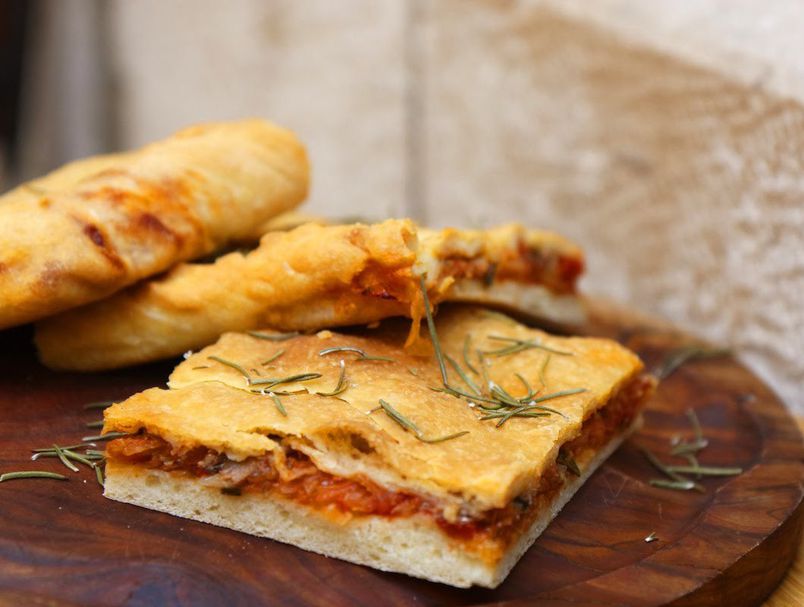
Viška or Komiška pogača is a traditional savory Dalmatian pastry originating from the island of Vis. One of Dalmatia’s beloved traditional dishes or appetizers, which also has roots in ancient Greece.
The dough, much like focaccia, is made with flour, salt, yeast, and warm water. It’s filled with a mix of olive oil, onions, anchovies, and spices.
There’s an ongoing debate about whether the pie should be baked in a rectangular or round shape. But regardless of its shape, when this hearty pie is paired with a glass of red wine, it makes for a perfect meal on its own. Although it’s often served as a warm appetizer.
Originally from the Island of Vis, it was a common snack or brunch option. Since it’s so filling, it could even be enjoyed as a quick lunch or light dinner.
Its quick preparation using leavened dough and savory filling makes it a popular dish on the island to this day. The leftover pie is typically served in triangular slices, filled with a mix of chopped anchovies or sardines, sautéed onions, spices, and capers as desired.
The slightly lighter body and fruity character with a softer structure of Vislander Plavac Mali blend from four grand cru positions of Plavac Mali on Vis island: Milna, Tihobraće, Voščice, and Ljubišće can enhance the flavors of Komiška pogača by providing a refreshing contrast to the savory and salty elements.
To truly savor the culinary tradition, the right wine is essential. This particular Plavac Mali from Vis Island perfectly complements the texture of Komiška pogača without overpowering it.
Recipes for Dalmatian food and wine pairings
Get ready to tantalize your taste buds with authentic Dalmatian flavor pairings that are sure to impress. Click here for more delectable recipes and wine pairings, and be prepared for a culinary adventure like no other!
Scampi buzara (Shrimp) in red tomato wine sauce
Scampi Buzara, a classic Dalmatian dish, features succulent shrimp cooked in a delightful red tomato wine sauce.
Traditional Dalmatian pašticada (beef stew)
This recipe showcases the traditional preparation of Dalmatinska pašticada, a classic dish from the Dalmatian region of Croatia.
Dalmatian pašticada, a traditional beef stew, is a beloved staple of Dalmatian cuisine. The dish showcases the region’s rich culinary heritage and reflects the influences of Mediterranean and Adriatic flavors.
Cooked to perfection with tender beef, aromatic spices, and a savory sauce made from local ingredients, pašticada offers a burst of authentic Dalmatian flavors in every bite. from the Adriatic wine regions, creating an exquisite dining experience that captures the essence of coastal Croatia.
Detailed preparing instructions
- Wash the beef, drain, and pat it dry.
- Make deep slits in the meat and insert cloves, pieces of garlic, and sticks of bacon in each.
- Pour a generous amount of wine vinegar into a large ceramic or plastic bowl (don’t use a metallic one!). Then, place the meat in the vinegar. Let the meat marinate in the vinegar overnight.
- Turn the meat from time to time so it gets marinated equally. If you can’t be bothered with turning the meat, besides vinegar, also add enough water to the bowl so the meat is completely submerged.
- The following day, add the meat and the lard to a large pot and sear the meat over medium-high heat. Once the entire surface is browned and the meat doesn’t release any liquid, take the meat out of the pot.
- Then, add the root vegetables and the spices to the same pot you were searing the meat in and sauté them until the onion is caramelized.
- Now, dissolve the tomato paste in prošek and pour that liquid into the pot with the meat. Once boiling, add water or stock so the meat is halfway covered, and cook over low heat for 3-4 hours until tender (turn the meat every 30 minutes). Add more stock or water as needed.
- When done, slice the meat, then place the slices into the sauce in the pot and cook for another 30 minutes.
- If the sauce is not thick and dark enough, separately sauté the breadcrumbs in a little bit of fat, then add a teaspoon of tomato paste. Add the mixture to the sauce and the meat near the end of cooking.
- Serve with gnocchi, creamy mashed potatoes, or homemade pasta.
Ingredients
- 750g (1 2/3 lbs) beef (frikando traditionally, or US rump or top round, or UK silverside or topside)
- A few cloves
- 4 garlic cloves, cleaned and cut into thick pieces lengthwise
- Bacon, cut into thick sticks
- About 1/2 L (2 cups) wine vinegar
- 1 large onion, finely chopped or grated
- 100g (3.5 oz) lard
- Celery root, a small piece, finely chopped
- Salt and pepper, to taste
- 1/4 – 1/2 tsp nutmeg, grated
- 120 ml (1/2 cup) prošek or red wine + 2 sugar cubes (to sweeten the red wine)
- 1 tsp tomato paste
- Stock or water, as needed
To thicken the sauce (if needed):
- 1 tsp breadcrumbs + 1 tsp tomato paste + a bit of lard
Pairing with Vislander Plavac Mali
This hearty and flavorful stew pairs beautifully with Vislander Plavac Mali Milna. For the ultimate Dalmatian Pašticada feast, you need a rich red wine. This full-bodied Plavac from Vis Island in southern Dalmatia perfectly complements the dish, with its powerful flavor and tannins that intensify every bite, creating a lasting flavor sensation.
Octopus under the lid with potatoes
A traditional Dalmatian dish loved in all parts of Croatia. Octopus is first simmered to soften, then baked under the lid with potatoes and garlic. White wine is added to speed up the cooking process.
Ingredients:
- 2 kg frozen octopus
- 1 kg baby potatoes
- 100 ml olive oil
- 200 ml white wine
- 3 cloves garlic
- 2 onions
- Salt, to taste
- Pepper, to taste
- Parsley, to taste
Instructions:
- Thaw, clean, and wash the frozen octopus. Place it in a pot over medium heat and sauté it dry, turning occasionally. Sauté until all the liquid evaporates, leaving behind a purple residue at the bottom of the pot. Once the octopus releases its water, remove it from the heat and set aside.
- Wash and halve the baby potatoes. Arrange them in a baking dish, sprinkle with salt, and add sliced onions. Place the octopus in the center and drizzle everything with olive oil and white wine.
- Cover with a lid and transfer to the grill. Bake for about 40 minutes.
- In the pot where you sautéed the octopus, add a little olive oil and sauté finely chopped garlic on the purple residue. Add pepper and parsley and cook for two minutes. Open the lid, pour the sauce over the octopus and potatoes, and let them soak for an additional 2-3 minute. Serve hot.
Pairing with Vislander Vugava
The traditional Dalmatian dish pairs beautifully with Vislander Vugava, a wine with a full body, balanced freshness, and just the right structure.
Best practices for coastal dining
When dining along the coast, choose a seaside restaurant with a view of the sparkling waters. Sample the freshest catch of the day and ask for recommendations from the sommelier to enhance your dining experience.
Choose a restaurant with a seaside view
When dining in Dalmatia, selecting a restaurant with a picturesque seaside view is essential for enhancing your culinary experience. The stunning coastal vistas create an idyllic atmosphere while you savor the local delicacies or some of the must-try summer dishes while pairing them with regional wines.
Gazing out at the Adriatic Sea as you dine adds an extra layer of enjoyment to your meal, offering a sense of tranquility and connection to the region’s rich maritime heritage.
Choosing a restaurant with a seaside view also allows you to fully immerse yourself in the coastal ambiance of Dalmatia. The gentle sea breeze and rhythmic sound of waves provide a soothing backdrop to your dining experience, making it truly unforgettable.
Sample the catch of the day
Experience the freshest flavors of Dalmatia by sampling the catch of the day. At coastal restaurants, we recommend selecting dishes featuring locally sourced seafood to savor the region’s culinary mastery.
Indulge in Adriatic treasures such as brudet, a delectable fish stew bursting with rich and savory flavors carefully prepared using traditional methods.
As you embark on your coastal dining experience, keep in mind that the unique climate and pristine waters contribute to the exceptional quality of seafood found in this region.
Ask for recommendations from the sommelier
Before you make your decision, we suggest seeking advice from the waiters and sommeliers. They can offer valuable suggestions on the ideal wines to complement Dalmatian specialties.
Alternatively, if you’re interested in exploring other options, you can also refer to our article on what to drink while in Croatia.
Conclusion
In conclusion, Dalmatia is a hotspot for wine lovers and food enthusiasts alike. More and more people are discovering this regions unique flavors and culinary traditions, rooted in its rich history.
For those who appreciate authentic food, respect for tradition, and fresh, local ingredients, Dalmatia has plenty to offer. One of the most authentic ways to experience the traditional pairing of Croatian wines and cuisine is by dining at one of the many “konoba” or taverns scattered across the coast.
Many of these charming eateries serve up hearty dishes we mentioned in this article.
With this detailed guide to pairing Dalmatian food and wine, we hope you’re ready to embark on a delicious journey through the culinary wonders of Dalmatia.




